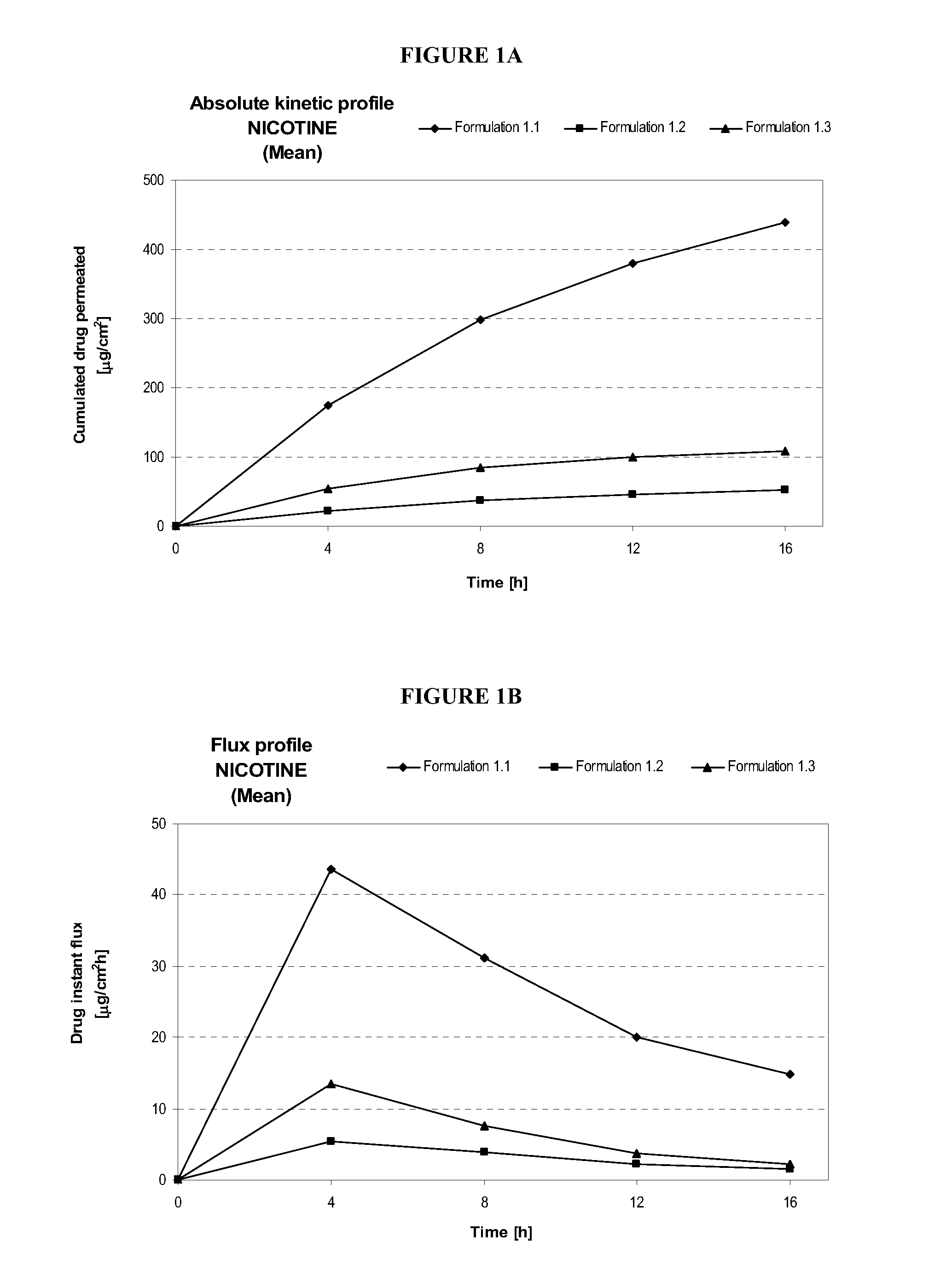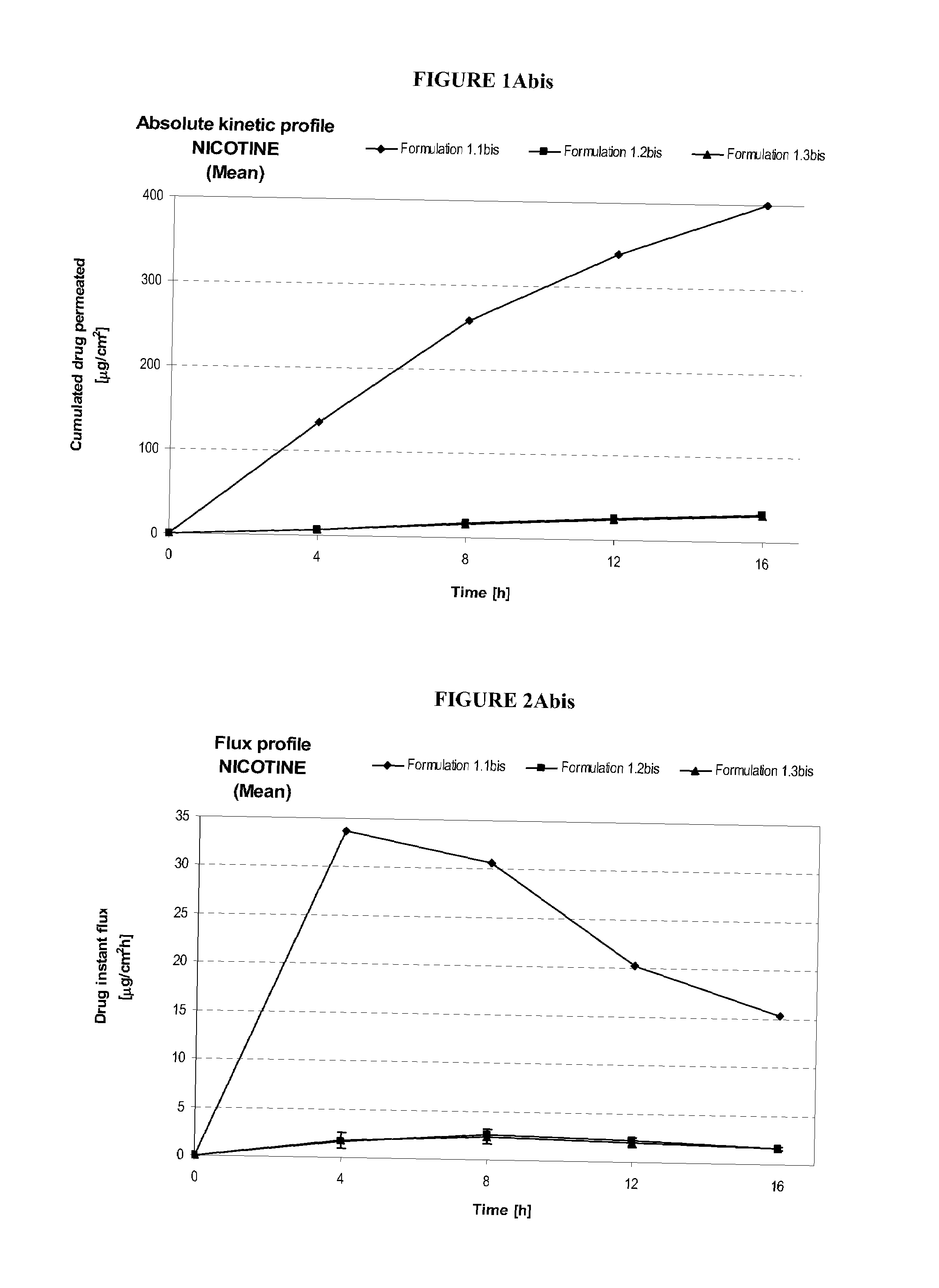Pharmaceutical compositions of nicotine and methods of use thereof
a nicotine and composition technology, applied in the direction of biocide, pharmaceutical non-active ingredients, plant growth regulators, etc., can solve the problems of limited number of drugs that can be administered transdermally, skin irritation or allergic reactions in some patients, and the difficulty of transdermal delivery
- Summary
- Abstract
- Description
- Claims
- Application Information
AI Technical Summary
Benefits of technology
Problems solved by technology
Method used
Image
Examples
example 1
Intrinsic In Vitro Permeation Results
[0214]Table 1 describes formulations that were evaluated for in vitro permeation. Evaluation of in vitro permeation was carried out as described in the Materials and Methods section using Franz cells.
[0215]
TABLE 1Composition of Formulations (% w / w)Formu-FormulationDrug Concen-lationDrug(%)tration (%)1.1S(-) NicotineNICORETTE ®0.83 mg / cm2Base10 mg / 16 h TTS(20 cm2)1.2S(-) NicotineDow Corning ST1.25BaseElastomer 10(74.25) / Cyclomethicone5NF(24.75)1.3S(-) NicotineDow Corning ST2.50BaseElastomer 10(73.5) / Cyclomethicone5NF(24.50)
[0216]In Table 1, the formulation and drug concentration percentages are given in weight percent. For Formulations 1.2 and 1.3, the nicotine free base was simply admixed to the mixture of silicones. The primary purpose of using these formulations was to evaluate intrinsic permeation of nicotine free base from a non occlusive semi solid formulation and to compare it to skin permeation of nicotine free base from a marketed occlusi...
example 2
Nicotine Hydrogen Tartrate Skin Permeation
[0237]Table 2 presents exemplary components of nicotine hydrogen tartrate gel formulations used in the following experiments.
[0238]
TABLE 2Composition of Formulations (% w / w)GeneralFormula-Formula-Formula-ComponentSpecific Componenttion 2.1tion 2.2tion 2.3Active DrugNicotine hydrogen4.274.274.27tartrate*SolventAbsolute Ethanol40.0040.0040.00CosolventsDiethylene glycol0.005.005.00mono ethyl etherPropylene glycol0.0015.0015.00PenetrationMyristyl alcohol0.000.001.00enhancerGellingHydroxypropyl cellu-1.501.501.50agentlose (Klucel HF)pH ModifierTriethanolamine7.437.107.19(50% w / w)SolventPurified water46.8027.1326.04Final pH~5.8~5.8~5.8Total100.00100.00100.00*Nicotine hydrogen tartrate 4.27% (MW = 462.401) corresponds to nicotine free base 1.5% (MW = 162.234), ratio 2.85.
[0239]Formulations 2.1, 2.2, and 2.3 were made essentially as described above in the Materials and Methods. Pig ear skin was used for the permeation studies using Franz cells as de...
example 3
Further Investigation on Nicotine Hydrogen Tartrate Skin Permeation
[0248]Table 4 presents exemplary components of nicotine hydrogen tartrate gel formulations used in the following experiments.
[0249]
TABLE 4Composition of Formulations (% w / w)GeneralFormula-Formula-Formula-ComponentSpecific Componenttion 3.1tion 3.2tion 3.3Active DrugNicotine hydrogen2.852.852.85tartrate*SolventAbsolute Ethanol40.0040.0040.00CosolventsDiethylene glycol5.005.005.00mono ethyl etherPropylene glycol15.0025.0025.00PenetrationMyristyl alcohol1.001.000.00enhancerGellingHydroxypropyl cellu-1.501.501.50agentlose (Klucel HF)pH ModifierTriethanolamine5.073.524.00(50% w / w)SolventPurified water29.5821.1321.65Final pH~5.7~5.4~5.6Total100.00100.00100.00*Nicotine hydrogen tartrate 2.85% (MW = 462.401) corresponds to nicotine free base 1% (MW = 162.234), ratio 2.85.
[0250]Formulations 3.1, 3.2, and 3.3 were made essentially as described above in the Materials and Methods. Pig ear skin was used for the permeation studies...
PUM
| Property | Measurement | Unit |
|---|---|---|
| surface area | aaaaa | aaaaa |
| pH | aaaaa | aaaaa |
| surface area | aaaaa | aaaaa |
Abstract
Description
Claims
Application Information
 Login to View More
Login to View More - R&D
- Intellectual Property
- Life Sciences
- Materials
- Tech Scout
- Unparalleled Data Quality
- Higher Quality Content
- 60% Fewer Hallucinations
Browse by: Latest US Patents, China's latest patents, Technical Efficacy Thesaurus, Application Domain, Technology Topic, Popular Technical Reports.
© 2025 PatSnap. All rights reserved.Legal|Privacy policy|Modern Slavery Act Transparency Statement|Sitemap|About US| Contact US: help@patsnap.com



